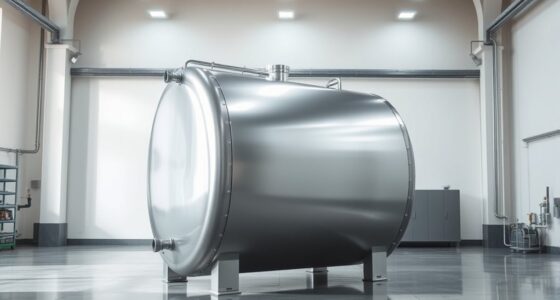Building an infinity pool yourself can take several months, as you’ll handle planning, permits, excavation, and construction step-by-step. It requires managing permits, sourcing materials, and gaining skills, which adds time and potential delays. On the other hand, hiring pros usually speeds things up, with installation taking around 2 to 4 weeks since they have experience and equipment. Curious how to make the process smoother? Keep exploring to find out more.
Key Takeaways
- DIY installation can take several weeks to months, depending on skill level and project complexity.
- Professional installation typically completes within 2 to 4 weeks, benefiting from specialized equipment and experience.
- Planning, permitting, and site prep are time-consuming steps that impact overall timeline regardless of method.
- DIY projects require more time for learning, trial, and error, potentially extending the schedule.
- Hiring pros streamlines coordination and reduces overall duration but may come at higher costs.
Planning and Design Phase
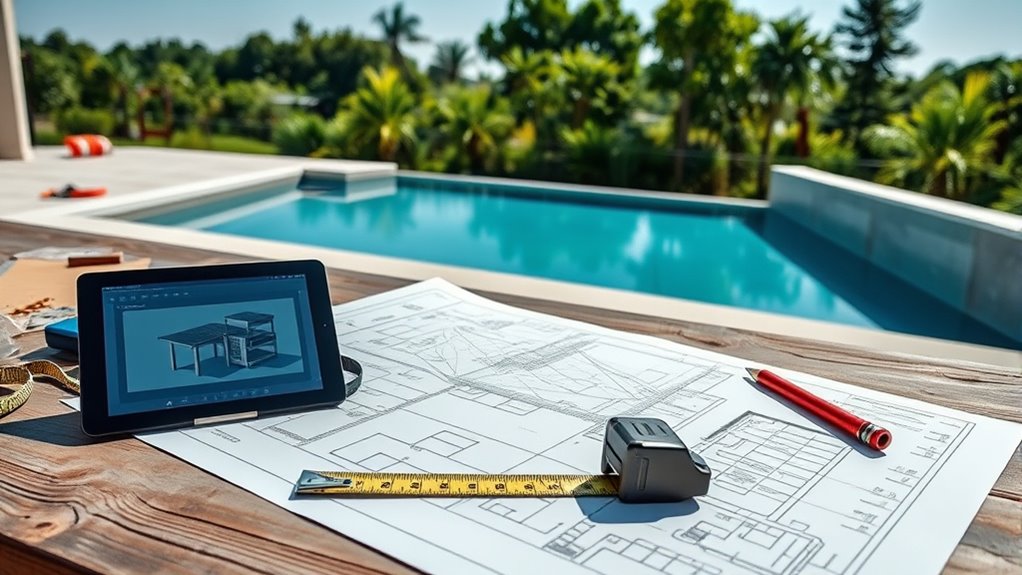
Have you ever wondered how much planning goes into a successful project? It’s a vital step that often determines the entire outcome. During the planning and design phase, you’ll decide on the pool’s size, shape, and features, tailoring it to your space and preferences. You should sketch out detailed plans, considering materials, structural requirements, and aesthetics. This stage also involves setting a realistic budget and timeline, ensuring you’re prepared for what’s ahead. If you’re doing it yourself, you’ll need to research techniques and tools, which can be time-consuming but rewarding. For professionals, this phase is streamlined with expertise and experience. Either way, thorough planning saves you headaches later, helping you anticipate challenges and make informed decisions before construction begins. Understanding the design and planning process can significantly improve your project’s success.
Permitting and Approvals

Managing the permitting process can take longer than expected, especially if there are unexpected delays. You need to understand the typical approval timeframes so you can plan your project accordingly. Keeping track of potential setbacks helps you stay prepared for any holdups along the way. Additionally, consulting with local building authorities early on can help identify any permit requirements and streamline the approval process.
Permitting Process Duration
The duration of the permitting process can substantially influence your project timeline, whether you’re pursuing a DIY approach or hiring professionals. Several factors affect how long it takes:
- Local zoning regulations and their complexity
- The completeness of your application and documentation
- The workload of the permitting office
- Whether additional approvals, like environmental or safety permits, are needed
Delays often occur if paperwork is incomplete or if specific regulations require extra steps. Some municipalities process permits quickly, while others can take weeks or even months. You might also face follow-up inspections or revisions, adding to your timeline. Knowing these factors helps you plan better and avoid surprises, ensuring your project stays on schedule. Additionally, understanding juice detox side effects can help you maintain your health during intensive projects, as a clear plan can minimize fatigue and other issues.
Approval Timeframes and Delays
Approval timeframes for permits and other approvals can vary widely, often causing delays that impact your project schedule. Local authorities may take anywhere from a few weeks to several months to review your application. Factors like zoning restrictions, permit complexity, and workload influence this timeline. Be prepared for unexpected hold-ups that can push back your start date. To stay on track, regularly check in with permitting offices and submit complete, accurate documentation. Here’s a quick overview:
| Permit Type | Typical Timeframe |
|---|---|
| Building Permit | 4-8 weeks |
| Zoning Approval | 2-6 weeks |
| Environmental Review | 3-10 weeks |
| Inspection Scheduling | 1-3 weeks |
| Final Approval | 2-4 weeks |
Staying informed about permit processing times and understanding the factors that influence delays can help you plan more effectively. Stay proactive to minimize delays and keep your project moving smoothly.
Site Preparation and Excavation
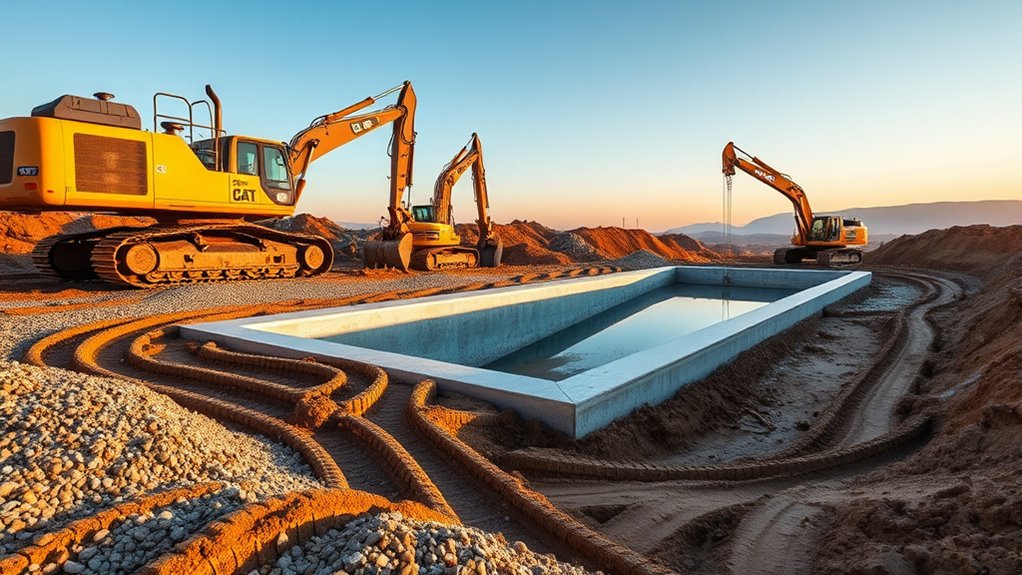
Before pouring the foundation, proper site preparation and excavation are essential steps that set the stage for a successful project. First, you need to clear the area of debris, plants, and anything that could interfere with construction. Next, level the ground to ensure stability and proper drainage. Third, mark the excavation boundaries precisely to avoid costly errors. Finally, dig out the site to the required depth, considering the pool’s design and structural needs. Skipping or rushing this phase can lead to uneven surfaces, water pooling, or foundation issues later. Taking your time during site prep guarantees a solid base, saving you headaches and expenses down the line. Proper excavation and preparation are the foundation of a safe, durable infinity pool. Additionally, understanding Kia Tuning options can help optimize the overall quality and performance of your pool area, ensuring a seamless integration with your outdoor vehicle and entertainment setup.
Construction and Installation
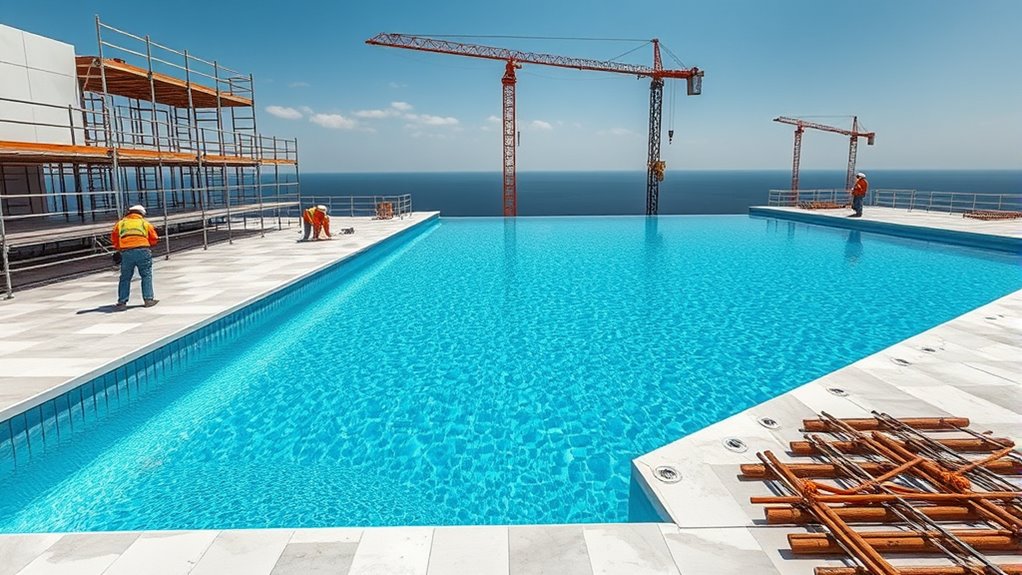
When beginning construction and installation, you’ll need to manage planning and permits to make certain of compliance. Next, focus on excavation and laying a solid foundation to guarantee stability. Finally, don’t forget finishing touches and water testing to confirm everything’s properly sealed and functioning. Utilizing proper surface preparation techniques and selecting the right equipment, such as an airless or HVLP sprayer, can significantly improve the quality of the finish and ensure a durable, long-lasting pool surface.
Planning and Permitting
Planning and permitting are essential steps that set the foundation for a successful DIY or professional installation. Without proper preparation, delays and legal issues can arise. Here’s what you need to do:
- Check local regulations and zoning laws to ensure your pool complies.
- Obtain necessary permits from city or county authorities before starting.
- Consult with homeowners’ associations, if applicable, for approval.
- Develop detailed plans and blueprints that meet code requirements.
- Recognize that creativity can be harnessed to problem-solve and adapt plans as needed during the permitting process.
Skipping or rushing these steps can lead to costly fines or project shutdowns. Taking the time to thoroughly plan and secure permits ensures your infinity pool installation proceeds smoothly and legally, giving you peace of mind and a solid start.
Excavation and Foundation
Have you prepared the site for your pool? Excavation is the first vital step. You’ll need to mark out the pool’s perimeter accurately and guarantee the ground is level. If you’re doing it yourself, rent a backhoe or excavator and proceed carefully, removing soil to the correct depth. For a professional, they handle precise measurements and heavy equipment efficiently. Once excavated, you’ll pour the foundation or footing, which provides stability and supports the pool’s structure. This step requires exact measurements to prevent shifting or settling later. Whether you’re DIY-ing or hiring pros, make sure that drainage is considered and that the base is solid. Proper site preparation is crucial for ensuring the longevity and safety of your pool. Skipping or rushing this phase can lead to problems down the line, so take your time to get it right.
Finishing and Water Testing
After completing the excavation and pouring a stable foundation, the next steps involve finishing the pool’s structure and ensuring the water quality is up to standard. First, you’ll seal joints and apply the finishing surface, whether tile, plaster, or aggregate, to create a smooth, durable interior. Second, you’ll install the filtration and circulation systems, essential for clean water. Third, you’ll fill the pool gradually, checking for leaks and ensuring proper water levels. Fourth, you’ll test the water chemistry—pH, chlorine, alkalinity—and adjust as needed to meet safety standards. This stage is critical for both aesthetics and functionality. Proper finishing and thorough water testing guarantee your infinity pool is safe, attractive, and ready for use. Additionally, understanding local regulations and safety standards can help ensure your project complies with regional requirements and is completed smoothly.
Finishing Touches and Landscaping
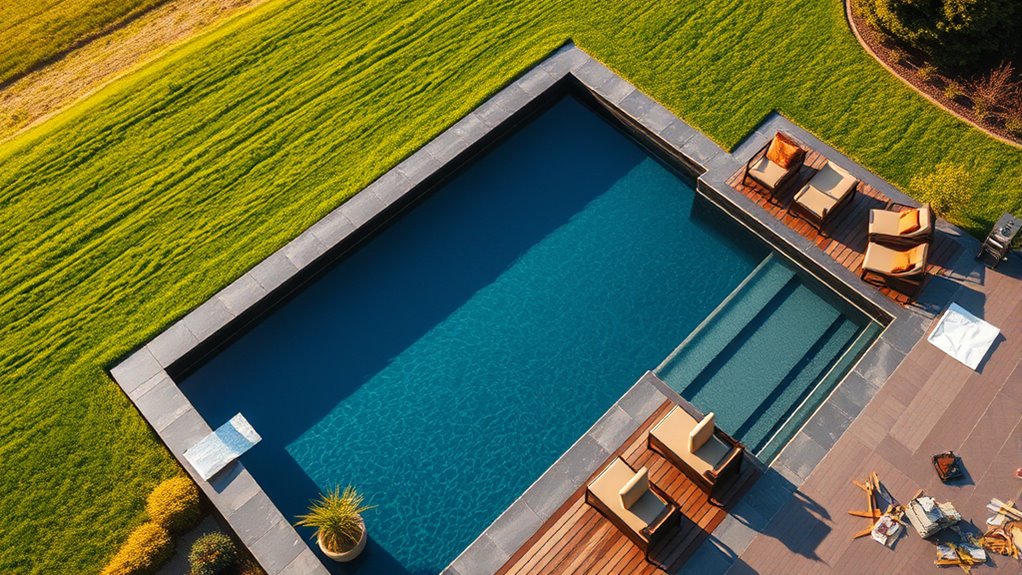
Once the main construction is complete, it’s time to focus on finishing touches and landscaping to enhance your home’s curb appeal. You’ll want to add features like lighting, outdoor furniture, and decorative elements that complement your pool. Landscaping plays a vital role—consider planting shrubs, flowers, or installing grass to create a lush, inviting environment. If you have a deck or patio, stain or seal it to protect against the elements. Keep pathways clear and well-defined for easy access. These details not only boost visual appeal but also increase safety around the pool area. Take your time to choose durable, weather-resistant materials that blend seamlessly with your home’s style. Incorporating community engagement into your project can also help you gather ideas and feedback from neighbors or local experts. Finishing touches transform your pool into a stunning, welcoming backyard oasis.
Inspection and Final Approval
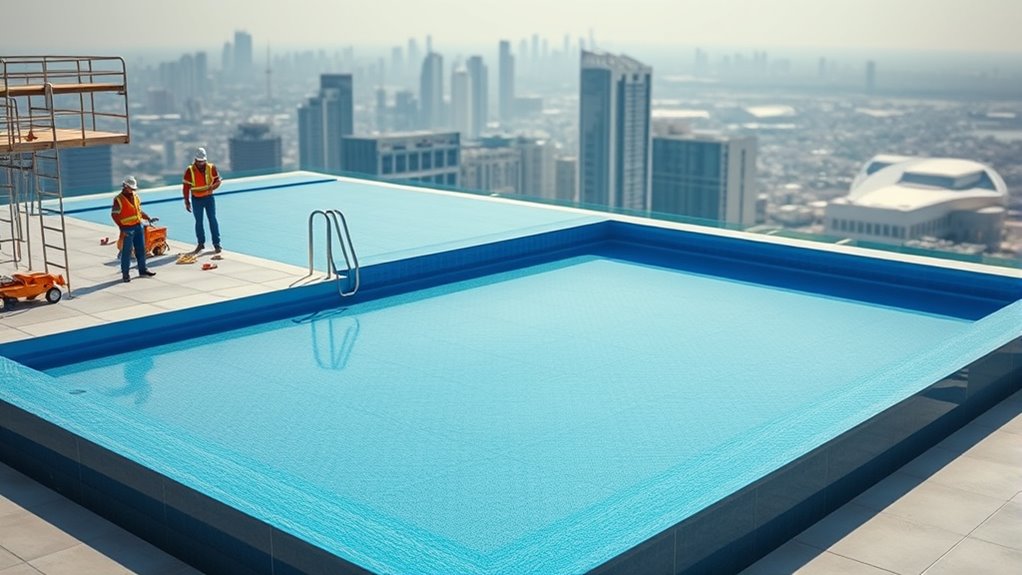
With your finishing touches and landscaping complete, it’s time to guarantee everything meets safety and building standards through an inspection. This step ensures your pool complies with local codes and is safe for use. Here’s what to expect:
- A thorough review of structural integrity and safety features.
- Checking electrical systems and waterproofing.
- Verifying plumbing connections and filtration systems.
- Approving safety barriers, handrails, and emergency features.
Once the inspector signs off, you’ll receive final approval, allowing you to fill your pool and enjoy it. Skipping or rushing this step can lead to costly issues later. Whether you hired a pro or did it yourself, thorough inspection certifies your infinity pool is safe, legal, and ready for use.
Estimated Timeframes for DIY vs. Professional Installation
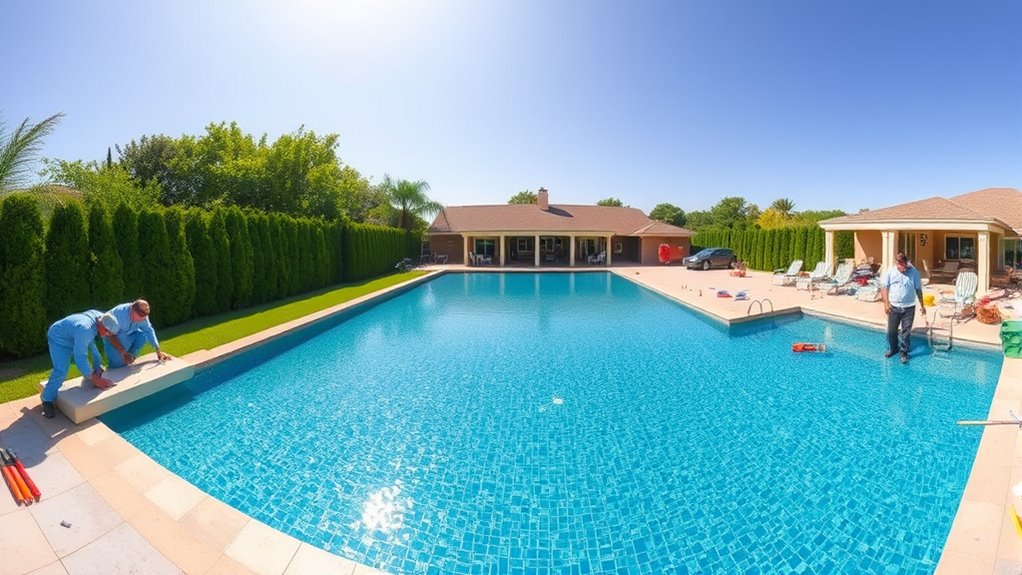
Installing an in-ground pool can vary substantially in duration depending on whether you choose to do it yourself or hire professionals. If you go the DIY route, expect the process to take anywhere from several weeks to a few months. You’ll handle everything from planning, excavation, and pouring the concrete to installing the finishes. It requires a significant time commitment and learning curve, especially if you’re new to construction projects. On the other hand, professional installation typically takes about 2 to 4 weeks, thanks to experienced crews and specialized equipment. They work efficiently, coordinating tasks like excavation, plumbing, and finishing seamlessly. While professionals may be faster, they also come with higher upfront costs. Your timeline ultimately depends on your skill level, project scope, and whether you’re willing to dedicate the necessary time.
Frequently Asked Questions
What Are Common Pitfalls During DIY Infinity Pool Installation?
You might overlook proper planning, which can lead to structural issues or water leakage. Skipping professional help may cause incorrect measurements or poor waterproofing, resulting in costly repairs. Using subpar materials or rushing the process can also compromise the pool’s integrity. Additionally, neglecting permits and safety regulations might delay or halt your project. To avoid these pitfalls, research thoroughly, follow guidelines carefully, and consider consulting experts for critical steps.
How Does Weather Impact the Installation Timeline?
Weather can be your project’s wild card, turning a smooth ride into a bumpy road. Rain, snow, or extreme heat slow down excavation, curing, and finishing. Storms might cause delays or even damage, pushing your timeline back. You’ll need to stay flexible and plan for weather windows, because just like a ship on the sea, your project’s progress depends on the skies clearing and conditions staying steady.
Can I Install an Infinity Pool in Winter?
You can install an infinity pool in winter, but it’s not ideal. Cold weather slows down concrete curing, affects material handling, and may cause delays. If you’re DIY-ing, you’ll face more challenges, like frozen ground and limited daylight. Hiring pros can help, as they’re experienced in winter installations and have equipment to mitigate weather issues. Be prepared for potential delays and extra precautions to guarantee a successful build.
What Are Hidden Costs in Professional Installation?
Hidden costs in professional installation can sneak up like a fox in the henhouse. You might face unexpected expenses such as permits, site preparation, or specialized equipment. Additional charges for custom features, landscaping, or unforeseen repairs can also add up quickly. To avoid surprises, always get a detailed quote and clarify what’s included. Being aware of these potential costs helps you budget better and prevents budget blowouts later on.
How Do Maintenance Times Differ Between DIY and Professional Pools?
You’ll find that maintenance times for DIY pools often take longer because you handle everything yourself, from cleaning to repairs. Professional pools usually require less maintenance time since experts know how to efficiently manage routine upkeep and troubleshoot issues quickly. While DIY might seem cheaper upfront, it can demand more time and effort, whereas professionals streamline the process, saving you time and ensuring your infinity pool stays pristine with minimal hassle.
Conclusion
So, whether you’re dreaming of a DIY infinity pool or calling in pros, remember—your masterpiece might look more like a kiddie pool with a slide or a sleek, floating oasis. Patience, skill, and a splash of luck will determine if you’re lounging in style or swimming in chaos. Either way, just don’t forget your floaties—because in the world of infinity pools, perfection’s just a ripple away. Happy building!



